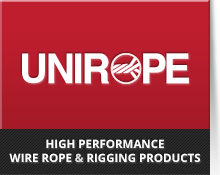Inspection of Chain Mesh Slings
Unirope Chain Mesh Sling Inspection Criteria (based on ASME B30.9-1)

Worn or abraided chain links. Gouged and nicked chain links. Stretched links due to overloading the sling |

Replace scorred and indented CMSS shaft rods Replace for broken tie-cables, distorted mesh structure |
| Use of Grade 100 Alloy Chain Mesh Slings in hot environments | |||
|---|---|---|---|
| Temperature of Chain in degree | Temporary Reduction of Rated Load while at Temperature | Permanent Reduction of Rated Load after Exposure to Temperature | |
| Celsius °C | Fahrenheit °F | ||
| Below 204 | Below 400 | None | None |
| 204 | 400 | 15% | None |
| 260 | 500 | 25% | 5% |
| 316 | 600 | 30% | 15% |
| 371 | 700 | 40% | 20% |
| 427 | 800 | 50% | 25% |
| 482 | 900 | 60% | 30% |
| 538 | 1000 | 70% | 35% |
| Over 538 | Over 1000 | Remove from Service | Remove from Service |
Chain slings shall be removed from service if any of the following conditions are present:
- missing or illegible sling identification.
- cracks or breaks.
- excessive wear, nicks, or gouges.
- stretched chain links or fittings.
- bent, twisted, or deformed chain links or fitting.
- evidence of heat damage.
- excessive pitting or corrosion.
- lack of ability of chain or fittings to hinge freely.
- weld slatter.
- other conditions, including visible damage, that cause doubly as to the continued use of the sling.
- broken or damaged connection steel cables.
- any damage to the shaft rods in SLIM CMSS fittings.
- a 15% reduction of the original cross-sectional area of any point around the hook opening of the end fitting.
- visible distortion of either end fitting out of its plane.
For sling inspection, re-certification and proof testing call Unirope®






